Chenin blanc
Chenin blanc (known also as Pineau de la Loire among other names) is a White wine grape variety from the Loire Valley of France. Its high acidity means it can be used to make everything from sparkling wines to well-balanced dessert wines, although it can produce very bland, neutral wines if the vine's natural vigor is not controlled. Outside the Loire it is found in most of the New World wine regions; it is the most widely planted variety in South Africa, where it was historically also known as Steen. The grape may have been one of the first to be grown in South Africa by Jan van Riebeeck in 1655,[1] or it may have come to that country with Huguenots fleeing France after the revocation of the Edict of Nantes in 1685. Chenin blanc was often misidentified in Australia as well, so tracing its early history in the country is not easy. It may have been introduced in James Busby's collection of 1832, but C. Waterhouse was growing Steen at Highercombe in Houghton, South Australia, by 1862.[2]
| Chenin blanc | |
|---|---|
| Grape (Vitis) | |
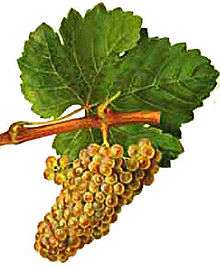 Chenin blanc in Viala & Vermorel | |
| Color of berry skin | White |
| Species | Vitis vinifera |
| Also called | Steen, Pineau de la Loire, Pinot blanco (more) |
| Origin | Loire, France |
| Original pedigree | Sauvignon blanc × Trousseau |
| Pedigree parent 1 | Sauvignon blanc |
| Pedigree parent 2 | Trousseau |
| Notable regions | Loire, South Africa |
| Notable wines | Vouvray, Coteaux du Layon, sparkling Saumur |
| Hazards | Bunch rot, sunburn, overproduction |
| VIVC number | 2527 |
It provides a fairly neutral palate for the expression of terroir, vintage variation and the winemaker's treatment.[3] In cool areas the juice is sweet but high in acid with a full-bodied fruity palate. In the unreliable summers of northern France, the acidity of under ripened grapes was often masked with chaptalization with unsatisfactory results, whereas now the less ripe grapes are made into popular sparkling wines such as Crémant de Loire. The white wines of the Anjou AOC are a popular expression of Chenin as a dry wine, with flavors of quince and apples. In nearby Vouvray AOC they aim for an off-dry style, developing honey and floral characteristics with age. In the best vintages the grapes can be left on the vines to develop noble rot, producing an intense, viscous dessert wine which may improve considerably with age.[4]
History
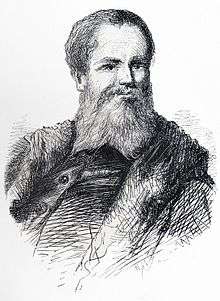
The French ampelographer Pierre Galet has theorized that Chenin blanc originated in the Anjou wine region sometime in the 9th century and from there traveled to Touraine by at least the 15th century.[4] The grape may have been the variety described in two royal land grants of Charles the Bald in 845 detailed in the records of the abbey of Glanfeuil as growing on the left bank of the Loire river in vineyards belonging to individuals with the name of Soulangé and Bessé.[5]
When Thomas Bohier purchased vineyard land around Chenonceaux on January 3, 1496, several grape varieties were brought in from the Burgundy wine region of Beaune, the Jura wine region of Arbois and nearby Orléans and Anjou. One of these varieties, a white grape known as Plant d'Anjou was later planted between 1520 and 1535 at a nearby site known as Mont Chenin in Touraine by the Lord of Château de Chenonceau and his brother in law, Denis Briçonnet, the abbot of Cormery. Ampelographers believe that Plant d'Anjou was like Chenin blanc with the grape eventually taking on the name from Mont Chenin.[5]
The French writer François Rabelais (1494–1553) wrote glowingly about the white wines of Anjou, and mentions the medicinal qualities of the grapes at the end of chapter XXV of Gargantua:
This done, the shepherds and shepherdesses made merry with these cakes and fine grapes, and sported themselves together at the sound of the pretty small pipe, scoffing and laughing at those vainglorious cake-bakers, who had that day met with a mischief for want of crossing themselves with a good hand in the morning. Nor did they forget to apply to Forgier's leg some fat chenin grapes, and so handsomely dressed it and bound it up that he was quickly cured.[6]
From France the grape spread to South Africa where it was most likely included among the vine cuttings sent to Jan van Riebeeck in the Cape Colony by the Dutch East India Company. In the 20th century it was discovered that a sub-variety of Chenin planted in the Loire was not actually Chenin blanc at all but rather the grape Verdelho, which is banned from French AOC regulations in the Loire.[3]
Relationship to other grapes
In 1999, DNA analysis has shown that Chenin blanc has a parent-offspring relationship with the Jura wine grape Savagnin. Additional DNA evidence shows that Chenin blanc shares a sibling relationship with Trousseau and Sauvignon blanc (both grapes the likely offspring of Savagnin) which strongly suggest that it is Chenin blanc that is the offspring and Savagnin is the parent variety. Through Chenin's half-sibling relationship with Sauvignon blanc, the grape is related as an aunt/uncle variety to the Bordeaux wine grape Cabernet Sauvignon which is the offspring of Sauvignon blanc and Cabernet Franc.[5]
Other DNA research has shown that a crossing of Chenin and the Hunnic grape Gouais blanc produced several varieties including Balzac blanc, Colombard and Meslier-Saint-François. In South Africa, the grape was crossed with the Italian wine grape Trebbiano to produce Weldra and Chenel.[5]
Over the years, Chenin blanc has also been frequently confused with other grape varieties with whom it does not seem to have a close genetic relationship. This includes the Portuguese wine grape Verdelho grown on the island of Madeira Machupiclait and in the Azores as well as the Spanish wine grape Albillo which was confused for Chenin blanc in Australia.[5]
Viticulture
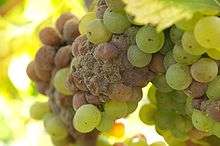
The Chenin blanc grapevine buds early in the growing season and ripens mid to late in the harvest year.[5] However, in warm years, the balance between the Loire's marginal climate and the warmth needed to attain full ripeness has the potential of producing wines with some depth of complexity and finesse. The age of the vine can have an influence on wine quality, with older vines producing naturally lower yields. When infected by noble rot, which also lowers yields and adds and intensifies certain flavors, the wines develop less overtly floral aroma notes but more depth and layers.[3]
New clonal varieties have been developed that delay budding and increase sugar development during the ripening phase. Six of these new clones have been officially sanctioned by the French government.[4] The vine is semi-upright in habit with 3-5 lobed leaves. It tends to break bud early, with conical, winged bunches containing yellow-green grapes that ripen late.[2] The berries are typically 16.0 mm long x 14.2 mm wide, with an average weight of 1.79g.[7]
The climate of a wine region will largely dictate whether Chenin blanc is produced in a predominately sweet or dry manner, while the vineyard soil type will generally influence the overall style of the wine.[5] Heavy clay based soils, paired with the right climate, is favorable to the development of weighty, botrytized dessert wines that need time to age and mature. Well-drained and less organic, predominately sandy soils tend to produce lighter styles of wine that mature more quickly. Chenin blanc planted in soils with a high silex content will produce wines with distinctive minerally notes, while limestone based soils will encourage wines with sharp acidity. In Vouvray the soil is predominately argilo-calcaire or calcareous clay, which produces rounded wines with both acidity and weight. In areas where schist is plentiful in the soil, Chenin blanc grapes will generally ripen earlier than in vineyards with predominately clay based soils.[3]
Among the viticultural hazards to which Chenin is susceptible (apart from botrytis in less than ideal conditions) are damage from spring time frost, powdery mildew, and fungal disease (such as Dead arm of grapevine) that affect the wood structures of the grape vine. Some of these hazards can be managed with integrated pest management and rootstock selection.[5][8]
Yields and harvest times
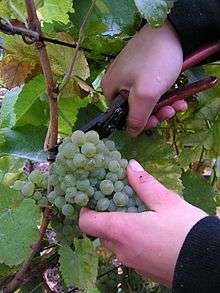
While true for most wine grape varieties, the quality of Chenin blanc wine is intimately connected to the care taken in the vineyard. If the grapes are harvested too soon, before they ripen, the high acidity of the resulting wine will be (according to wine expert Oz Clarke) "one of the nastiest wines possible". If the grapes are harvested at too high of a yield, the grapes will not retain any of Chenin blanc's distinctive character notes.[3] In the Loire, French regulations mandate that yields be kept low (40-50 hl/ha). At these levels, more of Chenin blanc's varietal characteristics of floral, honeyed aromas are exhibited. When the grape is harvested at high yields, such as the California Central Valley average of 10 tons per acre (175 hl/ha), Chenin's flavors become more bland and neutral.[4] The vine is naturally vigorous and prone to overcropping if not kept in check. In fertile soils, as in parts of South Africa, Chenin blanc can easily produce yields of 240 hl/ha. To keep yields in check, vineyard managers may choose to graft Chenin vines with less vigorous rootstock from Vitis riparia or Vitis rupestris vines. During the growing season, they may also elect to do a green harvest where excess grape clusters are removed.[3]
With optimal ripeness and balance between acidity and sugars being such a viticultural priority for Chenin blanc, many growers (such as those in the Loire Valley) will harvest the grapes in tries or successive pickings through the vineyards. During each series of picking only the ripest clusters or individual grapes are harvested by hand during a period that could last four to six weeks and include three to six passes through the vineyard. For the production of sweet botrytized wines, pickers will look for the grapes that have achieved the necessary amount of the noble rot. In hot and dry years where no noble rot occurs, pickers may leave ripened grapes on the vine long enough to shrivel, or passerillé, where it could later be effected by noble rot. In areas that experience a lot of vintage variation, winemakers may decide on a day by day basis what style and dryness of Chenin blanc they could make, with the grapes harvested during each tries going to different styles of wine. For some producers in Vouvray, which may have up to six tries during harvest, the first few tries could go to sparkling and dry wine production while the later tries could go towards sweet wine production.[3]
Wine regions
While Chenin blanc is planted across the globe from China to New Zealand, Canada, and Argentina, it is considered a "major" planting in only a few locations.[3] Though France is the viticultural home of Chenin blanc, by the turn of the 21st century there was twice as much Chenin blanc planted in South Africa as there was in France. The grape's versatility and ability to reflect terroir causes it to lead, what Jancis Robinson describes as, a "double life". In the Loire Valley of France, it is prized as a premium quality wine grape able to produce world class wines, while in many New World wine regions it used as a "workhorse variety", contributing acidity to bulk white blends and showing more neutral flavors rather than terroir. Throughout all its manifestations, Chenin blanc's characteristic acidity is found almost universally in all wine regions.[4]
France
Ampelographers theorize that Chenin blanc originated in the Loire Valley of France sometime in the 9th century. Today the Loire is the French wine region most closely associated with the variety. In 2008 there were 9,828 hectares (24,290 acres) of Chenin planted in France, mostly in the Indre-et-Loire, Loir-et-Cher and Maine-et-Loire department with the Anjou region around the city of Angers in the Maine-et-Loire having the most significant plantings with 5,044 hectares (12,460 acres) in 2008. While Chenin blanc still accounts for around 1.2% of all French plantings, these numbers are significant drop from the 16,594 hectares (41,000 acres) of grapevines that was in cultivation in 1958.[5]
Chenin blanc is an authorized planting in many Appellation d'origine contrôlée (AOC) regions but is mostly planted in the Middle Loire AOCs of Anjou, Bonnezeaux, Crémant de Loire, Coteaux de l'Aubance, Coteaux du Layon, Jasnières, Montlouis, Quarts de Chaume, Saumur, Savennières, and Vouvray.[4] The wines of the Coteaux du Layon, Bonnezeaux, and Quarts de Chaume are produced as sweet dessert wines, while Savennières produce predominately dry wines. The wines of Anjou, Crémant de Loire, Coteaux de l'Aubance, Jasnières, Montlouis, Saumur, and Vouvray have a wide range of sweetness levels, from dry to semi-sweet to sweet.[9]
In the 1970s, plantings of Chenin blanc in the Loire were uprooted in favor of the more fashionable red Cabernet Franc and white Sauvignon blanc as well as the easier-to-grow Gamay.[3] This consolidated Chenin's presence to the Middle Loire region around Anjou-Saumur and Touraine.[5] In the 1980s, interest in the sweet dessert wines of the Loire renewed enthusiasm for Chenin blanc in the region. During this time the Bordeaux wine region of Sauternes had experienced a series of favorable vintages that saw a dramatic increase in prices as supply began to dwindle in face of high demand. Wine consumers who had developed an appreciation for these sweet wines began to look to the Loire as another source. The 1990s brought a string successful vintages to the Middle Loire that produced many highly rated Chenin wines affected by noble rot. As wine expert Oz Clarke noted, these wines became the "standard-bearer" for Chenin blanc.[3]
The climate of the wine region tends to dictate what style of Chenin blanc is most prevalent in the area. In the northernmost reaches of Jasnières, Chenin blanc is at its limits for cultivation with the wines being mostly dry and thin. While most of the Middle Loire experiences a continental climate, the Coteaux du Layon receives more climatic influence from the Atlantic Ocean, which promotes the development of Botrytis cinerea, than in nearby Vouvray or Montlouis. While all three AOCs produce sweet, botrytized wine there tends to be less vintage variation in the Coteaux du Layon. The cool continental influence in Montlouis and Vouvray lends itself to producing a wide range of Chenin blanc including grapes with the necessary balance of acidity to sugar needed to produce sparkling wine. In the AOC of Savennières, there is less fog and mist from the nearby rivers and more wind that makes it difficult for botrytis to take root. This is part of the reason why Savennières is the one Loire AOC that produces predominately dry Chenin blanc. In the south of France, the warm Mediterranean climate of the Languedoc region encourages the production of much more dry styles of Chenin blanc rather than sweet.[3]
Other wine styles and French Chenins
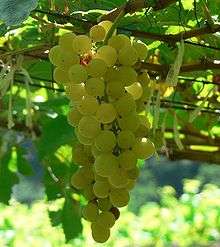
While most Chenin blanc is produced as a varietal wine, up to 20% of Chardonnay and Sauvignon blanc are permitted in wines with the basic Anjou, Saumur, and Touraine designations. The high acidity of Chenin blanc lends itself well to sparkling wine production where it is an important component of Crémant de Loire, sparkling Vouvray, and in the Languedoc wine region of Limoux.[4] In Crémant de Limoux, Chenin must account for at least 20% and up to 40% of the blend with Mauzac, Pinot noir and Chardonnay. The grape is also permitted in the still wines of Limoux but is only blended with Mauzac and Chardonnay.[5]
Outside the Loire, in addition to the Languedoc plantings in Limoux, other French plantings of Chenin blanc can be found in Corsica (with 60 hectares (150 acres) planted on the island in 2008[5]), Charentes, and the Aveyron department.[3] In South West France, it is permitted to be used in the white wines of the Côtes de Duras and the Garonne wines of Vins d'Estaing and Vins d'Entraygues et du Fel.[5]
South Africa

In South Africa, Chenin blanc is the most widely planted variety, accounting for nearly one-fifth (18.6%) of all vineyard plantings in the early 21st century. In 2008, there were 18,852 hectares (46,580 acres) of the grape planted, nearly twice the amount of Chenin blanc planted in France. The majority of the plantings are found in the Western Cape wine region of Paarl in the Cape Winelands District Municipality with 3,326 hectares (8,220 acres) with the Swartland region of Malmesbury and Olifants River not far behind with 3,317 hectares (8,200 acres) and 2,521 hectares (6,230 acres), respectively, in cultivation in 2008.[5]
The variety was most likely introduced to the country in the collection of vine cuttings sent to Jan van Riebeeck by the Dutch East India Company. For the next couple hundred years of South African wine history, the variety was known as Steen.[5] It was not until 1965 that ampelographers were able to concretely identify the numerous plantings of Steen around the country as being Chenin blanc. In the late 1960s and early 1970s, Chenin blanc was the principal grape in the South African wine industry's "white wine renaissance" that was ushered in by the introduction of new technologies such as temperature controlled fermentation vessels. During this time, the focus was on producing off-dry, clean, and crisp wine that was mostly neutral in flavor and could capitalize on the wine market's demand for white wine. Near the end of the 20th century, several Chenin blanc specialist producers emerged and worked with vineyard managers to isolate older Chenin vines on suitable terroir. Their goal was to produce wines that exhibited Chenin's unique aromas and traits. While plantings of Chenin blanc have decreased, the work of these producers resulted in improved quality profiles of South African Chenin blanc.[4]
United States
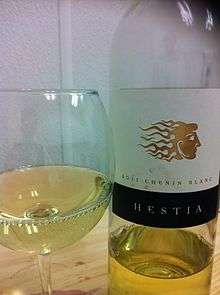
During the 1980s, the California wine industry had more acreage of Chenin blanc planted than France, though the numbers of plantings later steadily declined. By 2006, there were 13,000 acres (5,300 ha) planted mostly in the hot Central Valley. In 2010, this number was down to 7,223 acres (2,923 ha).[5]
For most of its history in the California wine industry, the grape was considered a "workhorse variety" that could be used anonymously in bulk and jug wine blends. Chenin's natural acidity and ability to adapt to wines of varying degrees of sweetness made it an ideal blending partner with Colombard and Chardonnay in mass-produced blends. It wasn't till close to the turn of the 21st century that producers in Sacramento Valley's Clarksburg AVA started to make quality varietal Chenin blancs a specialty; Chenin blancs from these producers tend to show a characteristic musky melon aroma and have the potential to age well.[4]
While Chenin blanc is grown throughout the United States, the American Viticultural Areas with the most significant amount of plantings include the California AVAs of Clarksburg, Napa Valley, and Mendocino, the Washington wine regions of the Yakima and Columbia Valley, and the Texas High Plains AVA.[10] In 2012, Washington had 200 acres (81 ha) of Chenin while Texas was growing 300 acres (120 ha).[5]
Other states in the United States with plantings of Chenin blanc include New York, Missouri, Wisconsin, Minnesota, Arizona, New Mexico, Maryland, North Carolina, Virginia, Idaho, Colorado and Texas. In 1990 there were 44 acres (18 ha) of Chenin blanc planted in Oregon, but by 2001 virtually all of it had been uprooted with only a few isolated plantings remaining.[3]
Other wine regions
In Australia, the country's 1,500 acres (610 ha) of Chenin blanc is mostly grown as a blending variety often used with Chardonnay, Sauvignon blanc, and Semillon. Australian Chenin plantings can be found in Tasmania, New South Wales, Victoria, and South Australia, as well as the Swan Valley and Margaret River area of Western Australia. Wine expert James Halliday describes the style of Australia Chenin blanc as "tutti-frutti" with pronounced fruit salad notes. However, the wines produced in Western Australia have garnered more critical attention.[3] In 2008, there were 1,586 acres (642 ha) of Chenin blanc in cultivation in Australia.[5]
In New Zealand, acreage of the variety fell to just under 250 acres (100 ha) by 2004. By 2008, that number had dropped to 124 acres (50 ha).[5] Planted primarily on the North Island, some examples of New Zealand Chenin blanc have drawn favorable comparisons to the sweet dessert styles of Chenin from the Loire Valley.[4] Historically the grape has been used as a blending partner with Müller-Thurgau in mass-produced blends. The success of some critically acclaimed New Zealand Chenin blancs has sparked interest in planting the variety. However, as experts such as Oz Clarke have noted, as long as the value of New Zealand Chardonnay and Sauvignon blanc stays high, there is little economic reason to pursue premium Chenin blanc production.[3]
Chenin blanc is found planted throughout South America, though for many years plantings in Mexico, Argentina, Brazil, and Uruguay were confused for Pinot blanc. The grape was used primarily in mass-produced white blends.[4] In Mexico, the grape is primarily found in Aguascalientes, Baja California and Coahuila. In 2008, Argentina had 7,186 acres (2,908 ha) of Chenin blanc, most of it in the Mendoza wine region, while Brazil, Chile, and Uruguay had 74 acres (30 ha), 188 acres (76 ha), and 17 acres (6.9 ha) of grapevines planted, respectively.[5]
The grape was exported to Israel in the 20th century, where it is still found in limited quantities.[5] Canada has Chenin blanc planted in the Okanagan wine region of British Columbia and in Ontario. Some plantings of Chenin blanc can be found in the Spanish wine regions, mainly in Catalonia.[11] In 2015, there were 112 hectares (280 acres) of the grape.[11] However, this number may rise as DNA analysis in 2006 discovered the Agudelo grape variety growing in the Galicia, Alella and Penedès wine region is actually Chenin blanc. The tropical wine regions of India and Thailand also has some limited plantings of the grape.[5]
Winemaking and wine styles
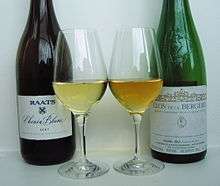
Wine expert Jancis Robinson has noted that Chenin blanc is probably the world's most versatile grape, being able to produce quality wines of various sweetness, including dessert wines noted for their aging ability, as well as sparkling made according to the méthode champenoise and fortified wines. The grape can distinguish itself as a single varietal wine, or it can add acidity as a blending component. Its ability to be crafted into premium quality wines across a wide spectrum of dry and sweetness levels invites the comparison to German Rieslings, with Robinson noting that in many ways Chenin blanc is France's answer to the German Riesling.[4]
One of the major differences between Old world and New world styles of Chenin blanc is the fermentation temperature. Old World style producers in the Loire tend to ferment their Chenin blanc at higher temperatures, 60-68 °F (16-20 °C), than New World producers in South Africa and elsewhere, usually fermenting their whites at temperatures around 50-54 °F (10-12 °C). This is because Old World wine producers tend not to put a premium on the tropical fruit flavors and aromas that come out more vividly with cooler fermentation temperatures. Chenin blanc can accommodate some skin contact and maceration which will allow extraction of phenolic compounds that could add to the complexity of the wine. Two of the aromas that skin contact can bring out is the characteristic greengage and angelica notes of Chenin. The grape's characteristic acidity can be softened by malolactic fermentation, which will give the wine a creamier or "fattier" texture as would a period spent aging on the lees. The use of wood or oak aging is up to each individual producer. Old World producers tend to shy away from the use of new oak barrels which can impart flavors of vanilla, spice, and toastiness; though these notes may be desirable for a New World producer. In Savennières there is a tradition of using acacia and chestnut barrels for aging; though acacia can impart a yellow tint to the wine, and chestnut barrels may add some buttery notes.[3]
Wines

The aromas and flavor notes of Chenin blanc often include the descriptors of minerally, greengage, angelica and honey. Chenin wines produced from noble rot will often have notes of peaches and honey that develop into barley sugar, marzipan, and quince as they age. Dry or semi-sweet Chenin blanc from the Loire will often have notes apple, greengage, and chalky minerals that develop into more honey, acacia, and quince aromas. New World styles of Chenin, such as those of South Africa, are more often made to be consume young and exhibit rich tropical fruit notes such as banana, guava, pear, and pineapple. The alcohol level for dessert styles Chenin rarely goes above 12%, which keeps the wines more in balance. Drier styles of Chenin are more likely to be around 13.5%.[3]
The aging ability of sweet Loire Chenin blanc is among the longest lived in the world of wine with well-made examples from favorable vintages regularly having the potential to last for at least 100 years.[3] This longevity is attributed to the grape's naturally high acidity, which acts as a preservative.[5] As phenolic compounds in the wine break down, they add complexity and depth to the wine. Some off dry or "demi-sec" examples may need at least 10 years before they start drinking at peak levels and could continue to develop for another 20 to 30 years. Sparkling and dry examples of Chenin blanc from premium production and favorable vintages have also shown longevity levels not commonly associated with white wine. However, as they age, Chenin blanc wines are prone to going through "dumb phases" where the wine closes up, revealing little aroma and varietal characteristics.[3]
Food pairings
Chenin blanc can be a very versatile player in food and wine pairings, but the wide range of wine styles needs to be taken into account. Lighter, dry styles can pair well with light dishes such as salads, fish, and chicken. The sweeter styles of Chenin blanc can balance the spicy heat of some Asian and Hispanic cuisines. The acidity and balance of medium-dry styles can pair well with cream sauces and rich dishes like pâté.[3]
Synonyms
Over the years, Chenin blanc has been known under a variety of synonyms including: Agudelo (in Spain), Agudillo (Spain), Anjou, Blanc d'Aunis, Blanc d’Anjou, Capbreton blanc (Landes, France), Confort, Coue Fort, Cruchinet, Cugnette, Feher Chenin, Franc blanc (Aveyron, France), Franche, Gamet blanc (Aveyron, France), Gros Chenin (in Maine-et-Loire and Indre-et-Loire), Gros Pineau (in Touraine), Gros Pinot Blanc de la Loire, Gout Fort, Luarskoe, Pineau d'Anjou (in Mayenne), Pineau de Briollay, Pineau de la Loire (in Indre-et-Loire), Pineau de Savennières, Pineau Gros, Pineau Gros de Vouvray, Pineau Nantais, Plant d’Anjou (in Indre-et-Loire), Plant de Brézé, Plant de Salces, Plant de Salles, Plant du Clair de Lune, Quefort, Rajoulin, Ronchalin, Rouchelein, Rouchelin (in Gironde and Périgord), Rouchalin, Rougelin, Steen (South Africa), Stein, Tête de Crabe, Vaalblaar Stein and Verdurant.[2][5][7]
See also
References
- "Cultivating in Good Hope". National Library of South Africa. Archived from the original on 2007-06-08. Retrieved 2007-06-17.
- Radden, Rosemary. "Grapes and Wines of the World". The State Library of South Australia, GPO Box 419, Adelaide SA 5001. Archived from the original on 2007-08-07. Retrieved 2007-06-17.
- Oz Clarke Encyclopedia of Grapes pg 75-83 Harcourt Books 2001 ISBN 0-15-100714-4
- Robinson, Jancis (2006). The Oxford Companion to Wine, Third Edition. Oxford University Press. pp. 160–161. ISBN 0-19-860990-6.
- J. Robinson, J. Harding and J. Vouillamoz Wine Grapes - A complete guide to 1,368 vine varieties, including their origins and flavours pgs 82, 236-238 Allen Lane 2012 ISBN 978-1-846-14446-2
- Translation based on that of Gustave Doré (1894) at Project Gutenberg of the following French :Ce faict, et bergiers et bergieres feirent chere lye avecques ces fouaces et beaulx raisins, et se rigollerent ensemble au son de la belle bouzine, se mocquans de ces beaulx fouaciers glorieux, qui avoient trouvé male encontre par faulte de s'estre seignez de la bonne main au matin, et avec gros raisins chenins estuverent les jambes de Forgier mignonnement, si bien qu'il feut tantost guery.
- Maul, E.; Eibach, R. (1999). "Vitis International Variety Catalogue". Information and Coordination Centre for Biological Diversity (IBV) of the Federal Agency for Agriculture and Food (BLE), Deichmanns Aue 29, 53179 Bonn, Germany. Archived from the original on 2007-04-11. Retrieved 2007-06-17.
- J.H.S. Ferreira "Effect of Rootstock on the Incidence of Dying Arm of Chenin blanc vines" Viticultural and Oenological Research Institute, Stellenbosch, Republic of South Africa. March, 1985
- Stevenson, Tom (2005). The Sotheby's Wine Encyclopedia. Dorling Kindersley. pp. 204–206. ISBN 0-7566-1324-8.
- Appellation American "Chenin blanc, Accessed: July 7th 2006
- Driscoll, Killian. "Guide to the wine grape varieties in Spain". www.artobatours.com. Retrieved 1 February 2020.
External links
- Chenin blanc from Winepros.org, with characteristics of its vine, grape and wine
- South African Chenin Blanc Association